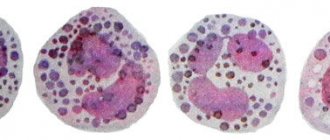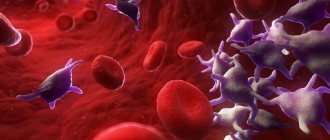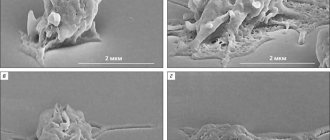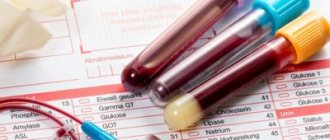Functions in the body
Hematocrit number is a specific laboratory sign that characterizes the ratio of blood cells to the total volume of biological fluid.
The source of a decrease or increase in the content of erythrocytes, leukocytes and platelets are various factors of an age-related, physiological, pathological nature:
- dysfunction of internal organs;
- inflammatory processes;
- malignant or benign neoplasms;
- pregnancy;
- hormonal changes;
- various diseases of the endocrine system;
- injuries;
- bacterial and viral infections, much more.
Each indicator separately does not have significant diagnostic significance. To assess the entire clinical picture in its entirety, a hematocrit value has been developed.
This laboratory sign makes it possible to identify pathological abnormalities at the initial stage of their development and formation. It provides grounds for more detailed diagnostics.
This is the main function of hematocrit in the body. This number is a kind of marker of diseases and pathological disorders. Based on the percentage of the liquid fraction of blood and formed components, the level of plasma state and active agents is determined.
What is hematocrit in analysis?
The hematocrit number is a special indicator included in a clinical blood test, which determines the content of red blood cells in the total volume of plasma, or the ratio of cells to the liquid part.
According to the definition, hematocrit in the blood is simply the ratio of formed elements by volume to the liquid part, or plasma. Thus, the hematocrit blood test (HCT) indicates the thickness of the blood indirectly, without directly measuring its viscosity.
It is known that red blood cells make up the largest number and largest volume of all cellular elements, and therefore we can consider that the blood density indicator is a method of assessing mainly the number of red blood cells in the liquid part of the blood, or more precisely, the effect of this mass on fluidity. Of course, there are also a lot of platelets, but there are fewer leukocytes. But their quantity cannot be compared with the huge mass of red blood cells, which has a main effect on viscosity.
Now we know what HCT is. What are the normal values of this value in the human body, and what reference values of hematocrit in a general blood test can be considered normal?
How and under what conditions is it produced?
Red blood cells, called red blood cells, are special cells that deliver oxygen and nutrients to tissues. This laboratory indicator determines their content relative to other formed elements.
Red blood cells consist of hemoglobin, a specific protein that captures oxygen atoms and transports them into cells, simultaneously removing carbon dioxide. The standard blood formula of a healthy person consists of 60% plasma (liquid) fraction and 40% formed elements.
Hematocrit (the norm in women varies by age under certain physiological conditions) characterizes their ratio with leukocytes and platelets, the total content of which does not exceed 1%. Indirectly, this laboratory parameter acts as an indicator of cell respiration.
The hematocrit value is used for:
- diagnosing anemia and assessing the effectiveness of its treatment;
- determining the level of tissue dehydration;
- making a decision on the advisability of hemosorption;
- obtaining data on the results of transfusion.
This specific laboratory sign is a component of a biochemical blood test and is not assessed separately. The hematocrit number is always directly related to the volume of red blood cells, provided that the latter are of standard size.
There is no relationship between the factors influencing the synthesis of intracellular hemoglobin and the level of their content in the blood plasma. The deviation of this laboratory indicator from the standard value does not necessarily indicate the presence of pathology, but serves as a basis for additional examination.
Norm
The normal hematocrit in a blood test is:
- hematocrit in men aged 18 - 45 years - 39 - 48%;
- hematocrit in men over 45 years old – 40 – 50%;
- hematocrit for women 18 – 45 years old – 36 – 42%;
- hematocrit in women over 45 years of age is 42–47%.
Table of hematocrit norms in a blood test
Hematocrit in the blood of children is somewhat different. The maximum hematocrit values are typical for newborns - 33 - 65%. With age, the hematocrit value in an adult gradually decreases and from the age of 6 it is established within the range of 33 to 44%.
The hematocrit indicator in a blood test is influenced by some physiological conditions of a person. Thus, during pregnancy its value decreases somewhat, which is due to mild anemia in women characteristic of this period.
Since the average volume of red blood cells in men is slightly higher than in women, the hematocrit number in this category of patients is also higher. But if various disorders develop in a man’s body, which affect the structural characteristics of red blood cells, laboratory hematocrit values may be inaccurate. For example, with the development of iron deficiency anemia, the size of red blood cells decreases. And although their number remains unchanged, laboratory testing shows a decrease in the hematocrit number.
If any deviations of the NST from the norm are detected in laboratory tests, it is necessary to conduct an additional examination to establish the true causes of such violations.
Indicator table is normal
The hematocrit number correlates with age and gender. Permissible deviation from the norm is no more than 5%.
Reference values are summarized in the table:
| Age | Women, % | Men, % |
| Newborns | 42-52 | 42-52 |
| Infants 6 months old | 34-44 | 34-44 |
| From 6 months to a year | 32,5-41 | 27,5-41 |
| 1-3 years | 30-40 | 28-40 |
| 3-6 years | 31-40 | 31-39 |
| 6-12 | 32-41 | 32-41 |
| 12-16 | 33-43 | 34-47 |
| 16-19 | 32-43 | 35-48 |
| 19-30 | 33-44 | 38-49 |
| 30-40 | 33-44 | 38-49 |
| 40-50 | 33-45 | 38-49 |
| 50-65 | 34-46 | 37-48 |
Hematocrit (the norm for women by age is indicated in the table) decreases in the presence of iron deficiency anemia. This is due to a decrease in the size of red blood cells. A hematocrit number below 30% and above 55% is considered critically dangerous.
With such indicators, the rheological properties of blood, in particular coagulation, are disrupted. Leukocytes, which perform a barrier function, cease to cope with their task.
This leads to the body's vulnerability to bacterial and viral invasion. At different ages, hematocrit values change, which is associated with an increase in blood volume and, accordingly, the formed elements of its formula.
Normal during pregnancy
When carrying a child, the hematocrit norm in women changes, as the body undergoes restructuring. Physiological changes make it possible to maintain pregnancy and prevent the development of complications in the expectant mother. In order to notice a deviation of HCT from normal values in time, you need to regularly visit the doctor and take the suggested tests.
Early
The hematocrit value in the first trimester varies from 33 to 36%. 1.5-3 months after conception, plasma volume increases by 10-15%. A decrease in hematocrit is observed at the end of the first or middle of the second month of pregnancy.
NBT less than 33% is an alarming symptom that may indicate the presence of anemia.
In the 2nd trimester
In the second trimester, the norm of hematocrit in the blood of women continues to remain at the same level (the same as in the first trimester). At the same time, the BCC (circulating blood volume) increases slightly, which requires constant monitoring of the expectant mother’s body.
A decrease in HT to 31% poses a threat to the health of the mother and fetus. This indicates the development of iron deficiency anemia or another pathological condition. An increase in hematocrit should also be feared, since it may be a sign of dehydration (dehydration). Loss of fluid in a pregnant woman can occur due to eating disorders (vomiting, diarrhea), toxicosis, profuse sweating, etc.
Important information: What is erythrocyte microcytosis in a general blood test in women (children)
In the 3rd trimester
In the last 3 months of pregnancy, BCC increases even more strongly (the most rapid increase is observed during 30-34 weeks of pregnancy). During this period, the hematocrit rate decreases until it reaches the minimum possible value: 32-34%. A further decrease in the indicator indicates the development of pathological conditions and requires treatment.
If your blood hematocrit rises above 36%, this may be a sign of dehydration.
Symptoms of increase and decrease
Signs of an imbalance in the proportions of red blood cells, white blood cells and platelets are manifested in various conditions.
Common symptoms with low hematocrit:
- apathy;
- prostration;
- chronic fatigue;
- constant drowsiness;
- dyspnea.
The symptoms are caused by the pathology or physiological condition that caused the change in the hematocrit number.
When this specific laboratory indicator increases, pain occurs:
- in the joints;
- spinal column;
- ribs;
- chest;
- in the limbs.
A common sign of an increase in hematocrit value is causeless swelling of soft tissues. The pain syndrome in each case has different intensity and duration.
A violation of hematocrit may be accompanied by a rise or fall in body temperature, suppression of appetite, and a yellowish tint to the skin of the face. Often the mucous membrane dries out, and ulcerative destruction appears in the oral cavity.
In especially severe cases, tactile sensitivity decreases and visual function is partially inhibited. If such alarming symptoms occur, there is every reason to suspect the development of a dangerous pathological process.
Reasons for promotion and demotion
The etiology of hematocrit disorders is numerous and varied. A decrease or increase in this specific blood parameter is caused by both natural causes, which resolve themselves over time, and pathologies that require immediate medical intervention.
Type 1 etiological factors include:
- heavy blood loss due to trauma or surgery;
- a debilitating diet and an unbalanced vegetarian diet low in iron;
- sedentary life (physical inactivity);
- dehydration of the body;
- taking diuretic medications and a course of treatment with loading doses of corticosteroid drugs;
- oxygen starvation, which the body tries to compensate for by increased synthesis of hemoglobin.
The latter reason may be caused by the region of residence (mountainous areas located high above sea level) or abuse of nicotine, which constricts blood vessels.
Pathological factors for hematocrit disturbances and deviations from the norm given in the table in women by age include:
- leukemia and other blood diseases;
- erythremia - proliferation of red blood cells;
- secondary erythrocytosis;
- tumor neoplasms in the renal organ, causing increased synthesis of erythropoietin;
- hydronephrosis and polycystic pathologies;
- Congenital heart defect;
- hemoglobinopathy;
- dysfunction of the lungs and other respiratory organs;
- sickle anemia.
Hodgkin's lymphoma, a malignant destruction associated with the proliferation of lymphoid tissue cells, leads to a violation of the hematocrit number. Red blood cells destroy some pathogenic agents and inhibit intoxication of the body with synthetic or organic poisons.
Reasons why hematocrit is increased
Physiological reasons
As a result of some changes in the body, the composition of the blood “adjusts” to them, as a result of which an increase in hematocrit in the blood may occur. These factors include:
- Age
Newborns have a large volume of red blood cells in their blood, so at first glance we can conclude that there is an increased hematocrit in the baby's blood. However, the figure of 44-62% is actually within the norm. After three months, the hematocrit drops to 32-44%, and after another 9 months – to 31-40%.
- Dehydration
The body seeks to compensate for water deficiency by reducing plasma in the blood, therefore the total volume of circulating blood (TBV) decreases, and the proportion of red blood cells in it increases, and therefore an increased hematocrit in the blood is observed. Dehydration can occur with low water intake, excessive sweating, frequent diarrhea and vomiting. Hematocrit is increased during pregnancy at the stage of toxicosis.
- Hypoxia
Smokers often experience a lack of oxygen in the body - hypoxia. Hemoglobin, which is part of red blood cells, is responsible for transporting oxygen to all organs and removing carbon dioxide from them. If less oxygen is supplied than necessary, the body tries to compensate for this by producing additional hemoglobin. As a result, the number of red blood cells increases and the hematocrit HCT in the blood test is increased.
Hypoxia can also occur in people who have spent several days in the mountains. Their lungs have not yet had time to adapt to the rarefied mountain air, which contains less oxygen, so the hematocrit increases.
Indications for the study
A blood test to determine the hematocrit number is prescribed if the patient has a history of genetic mutations, hereditary diseases, or renal failure.
Common provocateurs of disturbances in the proportions of blood cells:
- oncology of any localization;
- abnormally low levels of protein compounds in plasma and serum;
- thalassemia - inhibition of the secretion of polypeptide chains that are part of the structure of hemoglobin;
- multiple myeloma;
- peritonitis;
- dynamic injuries of internal organs;
- fractures;
- hemoblastosis – a tumor of hematopoietic and lymphatic tissue;
- renal vessel stenosis;
- dysbacteriosis;
- cirrhosis;
- malaria;
A laboratory analysis to determine the Ht indicator is prescribed by a hematologist or family doctor for varicose veins of the esophagus, damage to the spinal cord of any origin, poisoning with hemolytic poisons and salts of heavy metals.
In 20-25% of cases, hematocrit disorder is provoked by anemic pathologies.
The risk group includes people with certain physiological conditions:
- consuming a large daily volume of liquid;
- 4th month and later pregnancy;
- active stage of the menstrual cycle;
- excessive absorption of table salt;
- postpartum period.
Women and children are more likely to experience a decrease in Ht, while men are more likely to experience an increase.
Causes and treatment of deviations
To understand what to do if the hematocrit deviates from the norm, you need to understand why this happens.
Increased content
When the hematocrit number increases, the blood thickens. This can lead to the development of thrombosis and other cardiovascular complications. An increase in HCT in a general blood test occurs for the following reasons:
- Dehydration. Loss of fluid or insufficient consumption is fraught with dehydration and a decrease in blood volume. This condition can be a consequence of overheating, diarrhea, vomiting, or increased sweating during intense physical activity.
- Pregnancy. With the development of late toxicosis, kidney function is disrupted, so the hematocrit increases. The closer to the end of the term, the thicker the blood becomes: this is how the body prepares for childbirth, often associated with large blood losses.
- Hypoxia. In conditions of oxygen deficiency, active formation of red blood cells occurs. These cells deliver oxygen to the tissues of internal organs, ensuring their normal functioning. Hypoxia can occur with smoking, prolonged stay in stuffy rooms, and the presence of diabetes mellitus.
- Accommodation in mountain conditions. Thin air contains insufficient oxygen, so in the mountains there is an increase in hematocrit levels. To ensure your well-being when climbing to the top or working at heights, you need to use oxygen cylinders.
- Kidney disorders. Diseases of the renal apparatus (polycystic disease, hydronephrosis, etc.) increase the number of red cells in the blood.
- Drug treatment. Uncontrolled (long-term) use of diuretics and corticosteroids is fraught with an increase in hematocrit. This is due to the fact that these drugs stimulate the removal of fluid from the body.
Other pathological conditions that can cause a deviation from the norm are:
- suffered stress;
- disturbances in the gastrointestinal tract;
- bone marrow pathologies;
- skin injuries (more than 10% of the body);
- the presence of diseases of the respiratory system: obstructive bronchitis, bronchial asthma (with these diagnoses, the supply of air to the lungs becomes difficult, and the process of hematopoiesis intensifies).
If the hematocrit is reduced, the norm can be restored using an integrated approach. You need to start by eliminating the cause that caused the increase in red blood cells in the blood. If necessary, medications that thin the blood and prevent the formation of blood clots should be used. You can take such drugs with the permission of a specialist.
Important information: What is PDW or platelet population distribution width and deciphering the norm in a general blood test
Reduced level
If your blood test shows a low HCT, it means that the percentage of red blood cells in your blood has decreased. There may be several reasons for this condition:
- Blood loss. A decrease in hematocrit in a blood test may be a symptom of bleeding. The danger is not only from external bleeding caused by various injuries, but also from hidden ones. The latter can occur with cirrhosis of the liver, uterine fibroma, disintegration of neoplasms, thallasemia, dilation of the esophageal veins and other pathological conditions.
- Overhydration. This condition can occur with large fluid intake, intravenous infusions, and renal failure. In such cases, the blood volume increases, which leads to a decrease in hematocrit.
- Drug therapy. A decrease in the indicator can be caused by prolonged or frequent use of medications (including Aspirin).
- Hyperproteinemia. This condition can occur with vomiting, diarrhea, myeloma, acute infectious diseases, paraproteinemic hemoblastoses, lymphogranulomatosis. Increased protein levels in the blood retain fluid and cause an increase in plasma volume.
- Active destruction of red blood cells. Red blood cells are destroyed during severe infections (malaria, typhoid fever), intoxication of the body (salts of heavy metals, toadstool), acquired and hereditary hemolytic anemia.
- Impaired formation of red blood cells in the bone marrow. The reasons for such disorders may lie in anemia, leukemia, kidney paresis, treatment with anti-blastoma and cytostatic drugs.
To return the hematocrit to normal, it is necessary to eliminate the cause of the development of erythremia. If a decrease in the concentration of red blood cells occurs due to anemia, you need to reconsider your diet. If you have a low hematocrit, it is recommended to eat foods high in iron: red and chicken meat, legumes, seafood, dried fruits, eggs, greens, offal (especially liver). If this is not enough, you need to consult a doctor to choose a medicine or dietary supplement with iron.
Changing your diet will help return your hemoglobin and hematocrit levels to normal. It is also recommended to increase the intake of ascorbic acid (vitamin C), as it promotes better absorption of iron from food and medications.
How to determine
Venous blood is taken for analysis. It is filled with special medical test tubes made of transparent graduated glass or plastic. The biological fluid is processed by centrifugation to separate the blood into fractions.
Hematocrit (the norm in women by age depends on the physiological state to a greater extent than in men) is calculated using a micro- or macroscopic method. The latter is considered more accurate.
The blood is mixed with an anticoagulant laboratory reagent, which prevents the clotting of biological fluid. The test tube containing the compositions is installed in a centrifuge apparatus. The blood processing process lasts about 1.5 hours.
During this time, the test tube is spun to the maximum speed for the technical characteristics of the laboratory centrifuge model. All components of the blood formula differ in specific gravity and density. Therefore, they are easily separated into layers.
After the centrifugation process is completed, the laboratory assistant determines the percentage of each fraction using a high-precision scale applied to the test tube. Since red blood cells are the heaviest formed elements in blood, they settle to the bottom of the flask.
Leukocytes and platelets are placed sequentially above them. The topmost layer is occupied by plasma purified from functional cells. For maximum analysis accuracy, the test tube is marked with 0.01 to 100.00%.
All biological material placed in a laboratory vessel is taken as 100%. Further definition is not difficult. The resulting indicator is considered the hematocrit number. If the test is taken after blood loss, including menstruation or surgery, it may be distorted.
How is HCT determined?
Special laboratory tests are used to determine the level of HCT. They are carried out using a glass graduated tube, which is also called hematocrit. It is filled with blood and centrifuged, which helps to identify which part of the tube is occupied by formed elements of biological fluid. The principle of determining the hematocrit number:
- deprivation of blood clotting using isotonic and dry anticoagulant;
- centrifugation to separate red blood cells from plasma, which takes place within a standard time and a certain number of revolutions.3
There are two methods for determining hematocrit: micromethod (microhematocrit), macromethod (macrohematocrit). The results obtained using the second method are slightly higher compared to the first. Dividing the blood in a centrifuge into plasma and the following layers helps to determine the number of red blood cells:
- Red blood cell mass . It is a red translucent agent located at the bottom.
- Red blood cells with restored metabolic activity due to nearby red blood cells. They are represented by a narrow dark stripe called the Braunberger layer.
- Leukocytes and platelets . They look like a gray-whitish layer.
Preparing and conducting analysis
The established rules for preparing for donating blood for laboratory testing also apply to determining the hematocrit number:
- The biomaterial is collected in the morning on an empty stomach.
- The last meal should be at least 8 hours before the test.
- Blood sampling will be facilitated by drinking plenty of clean water without gas and sugar, which dilutes the biological fluid.
- The analysis is not carried out against the background of drug therapy with diuretic, anticoagulant and corticosteroid drugs.
- Before the procedure, it is better not to take any medications at all.
The concentration of blood cells is significantly affected by physical activity and psycho-emotional stress. Therefore, it is advisable to be in a state of rest and balance during the procedure.
The puncture site is pre-treated with an antiseptic composition. Blood is drawn into a regular 20 cc syringe or into a special vacuum container with a medical needle. From there it is poured into a graduated laboratory test tube.
The analysis result is distorted:
- helminthic infestations;
- colds;
- influenza strain;
- food poisoning;
- any intoxication of the body;
- avitaminosis;
- changes in hormonal levels.
If you have such conditions, it is advisable to refrain from taking tests.
Laboratory microscopy
Calculation of the hematocrit number is included in the general clinical blood test. A separate study of this indicator may be prescribed in case of unsatisfactory results of OKA: anemia (anemia) and high concentration of red blood cells, as well as in case of bleeding of various etiologies (origins), in case of dehydration (dehydration) of the body. HCT is an important indicator of chronic hematological diseases.
To obtain objective final data, on the eve of the study, the patient is recommended to eliminate heavy foods (fatty and fried foods) from the diet, eliminate alcohol-containing drinks, and limit sports and other physical activities. The blood sampling procedure is carried out in laboratory conditions, in the morning.
Before the analysis, it is advisable to give up breakfast and smoking. The hematocrit value is determined using a laboratory device into which a glass graduated tube containing the blood sample being tested is placed. An anti-clotting agent is first added to the biofluid.
Decoding the results
The analysis is interpreted by a doctor. However, the results of the study are not difficult to understand on your own. A balanced blood formula has a 6:4 ratio between plasma and the total content of formed elements.
Depending on the fluctuation in one direction or the other, the Ht indicator is considered increased or decreased. The average (reference) value is strictly correlated with age and gender. Additional physiological factors are usually at play.
Hematocrit (the norm for women by age should not go beyond 30-45%). For men, this figure varies in the range of 35-49%. A 5% deviation is acceptable. If it is greater, the hematocrit number is considered underestimated or overestimated.
This result may be caused by temporary natural causes and may not have diagnostic significance. But in any case, medical consultation and additional examination are strongly recommended.
Disturbances in the balance of blood cells are often associated with dangerous pathologies - oncological, endocrine, cardiovascular.
General views
Many patients and their relatives, encountering the name of this indicator for the first time, wonder: what is hematocrit in a blood test? Blood consists of two components - the liquid part (plasma) and a suspension of formed elements in it. The ratio of these two components is called hematocrit. But it would be more correct from a professional point of view to use the term hematocrit number.
Since the largest number of all blood components is erythrocytes, determination of the hematocrit number in laboratory conditions can indirectly provide information about the number of red cells in the bloodstream at the time of the examination.
Hematocrit is of great importance in diagnostic terms for such conditions in the patient as dehydration of the body with continuous vomiting and diarrhea observed with various intoxications, with burns affecting large areas of the body.
The determination of hematocrit is not included in the clinical blood test; the doctor prescribes its study as a separate analysis.
Scheme for determining hematocrit
The designation of hematocrit in a blood test - HCT, short for the Latin hematocrit, is used in new models of laboratory equipment and is indicated as such in printouts obtained from the automatic interpretation of examination results by the machine.
How to get it back to normal
The success of therapy and restoration of the Ht indicator lies in eliminating the imbalance of the blood count. In frequent cases, special clinical measures are not required. It is enough to change your lifestyle, give up addictions to alcohol and nicotine, and adjust your diet.
They will help quickly bring the hematocrit value back to normal:
- regular walks in the fresh air;
- ventilation of the room and daily wet cleaning;
- drinking large amounts of water;
- refusal of uncontrolled use of medications - Analgin, Aspirin and others, which are in every home medicine cabinet;
- playing sports or morning exercises;
Alcohol and caffeine are diuretics that lead to an imbalance of red blood cells. It is necessary to stop using them. These drinks dehydrate the body and stimulate urinary function.
This category also includes carbonated water and sweet juices. Antioxidants protect the body from free radicals, helping to saturate cells with oxygen. For sports activities, morning jogging and leisurely cycling are recommended.
Medications
Drug therapy is aimed at eliminating the cause of the imbalance of blood cells. A universal technique has not been developed. The doctor prescribes treatment only after a complete examination and identification of the cause of the hematological disorder.
For peptic ulcer disease, which often leads to a violation of the Ht indicator, a gastroenterologist develops therapeutic tactics. Usually it includes a complex intake of drugs that suppress symptoms - anabolics, antiemetics, antispasmodics.
Additionally, analgesics are prescribed. To maintain the body's defenses, vitamin complexes and immunostimulants are prescribed.
Inflammation and dysfunction of the renal organ are treated:
- antibiotics;
- sulfa drugs;
- uroseptic agents;
- antibacterial drugs of the nitrofuran group.
Physiotherapeutic procedures are used. Therapy for anemic syndrome, which leads to a violation of the blood formula, is developed depending on the severity of the pathology. If the hematocrit is elevated, a course of medications is often prescribed to dilute the biological fluid.
In severe cases, a replacement solution is infused, which reduces the viscosity of the blood and improves its rheological properties.
Traditional medicines for hematocrit disorders:
- Interferon;
- Hydroxyurea;
- Anagrelide;
- Myelosan;
- radioactive phosphorus.
The doctor prescribes the duration of the course of treatment, dosage and combination of drugs individually based on the patient’s clinical picture and medical history.
Traditional methods
If a hematocrit disorder occurs, diet correction is necessary.
Traditional recipes include the use of iron-containing and protein-rich foods:
- chicken eggs;
- beef and pork;
- seaweed;
- legumes;
- sturgeon caviar.
It is advisable to include apples, dried apricots, and raisins in your diet. If the cause of an imbalance in the blood formula is iron deficiency anemia, you can make a special nutritious cocktail from carrots, beets and radishes.
They are passed through a coarse grater, squeezed out and the juice is poured into a saucepan. It is placed in the oven and simmered for 3 hours on the lowest flame. Take the resulting decoction 3 times a day after meals. The full course of traditional therapy is 3 months.
Other methods
If a decrease in hematocrit number is associated with loss of strength and chronic fatigue syndrome, you can take 1 tbsp before meals. garlic squeeze with honey, boiled over low heat for 5 minutes.
150 ml of aloe extract mixed with 200 g of natural honey and a glass of Cahors wine helps well in this condition. This remedy will increase the hemoglobin content in the blood. They drink it 1 tbsp. 3 times a day before meals.
To treat hematocrit disorders with home methods, use garlic tincture in 96% alcohol. The vegetable is crushed and filled with flammable liquid. The solution needs to be kept for 2-3 weeks in a hermetically sealed bottle. Take 20 drops three times a day per glass of fresh cow's milk.
Possible complications
Imbalance of the blood formula leads to acid-base imbalance in the body, dysfunction of internal organs, and creates favorable conditions for the invasion of pathogenic pathogens. This is fraught with numerous complications and the formation of severe pathologies.
With increased blood viscosity, it is difficult to remove waste and toxins from the body, and the protective abilities of the immune system are suppressed.
Life-threatening pathologies resulting from hematocrit disorders:
- myocardial infarction;
- ischemic or hemorrhagic stroke;
- airway spasm;
- gangrene of the limbs requiring surgical amputation.
A change in the rheological properties of blood in a pregnant woman’s body leads to highly complicated labor and fetal hypoxia. A child may be born with severe disorders of the central nervous system, destruction of bones and muscle fibers.
In such a responsible physiological state, a woman needs to carefully ensure that the hematocrit is normal. By age, such a deviation is more typical for pregnant women after 35 years of age than for young girls. If the Ht value is very high, the risk of developing thrombosis and vein blockage increases sharply.










